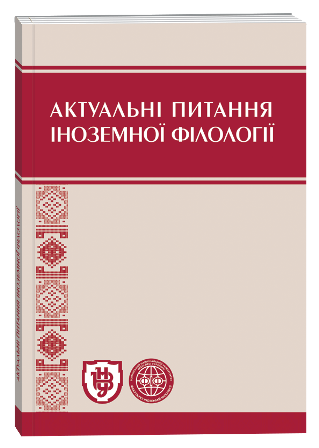THE POETICS OF DYSTOPIA IN THE NOVEL «THE HANDMAID’S TALE» BY MARGARET ATWOOD
Keywords:
dystopia, discourse, symbolism, intertextuality, style, masteryAbstract
The article deals with a figurative picture of the novel «The Handmaid's Tale» by a modern Canadian writer Margaret Atwood, embodied in the genre of dystopia. The peculiarities of the artistic and aesthetic reality of the work, the characteristics of the author's style, the magnitude of representation are focused on. The conceptual features determined by a dystopia genre, the composition and style of the novel, the inherently natural manner of the artistic rendering of the novel and its dependence on the level of aesthetic tastes and writer’s philosophy of life have been analyzed. There are different characteristics of dystopia, presented by the writer: the absence of a clear protagonist who opposes the system, a clear denouement that would cause the reader's katharsis, pre-emphasis on the passive role of a narrator and, in general, of all the inhabitants of the country. The novel is perceived as innovative, this is facilitated by openness at the event level, which leads to a dialogue between the author and the reader, to the speculation about the negative influence of the totalitarian state system on the consciousness and the behavior of the person. The specifics of such a society have been analyzed, in which, despite the external well-being of the commonwealth, negative trends in its development are noticeable. The problem of the social role of a woman, where she performs only certain specific to her functions, has been revealed. Such a limitation in the right of choice does not contribute to the development of the person, does not diversify person’s behavior, leads to the loss of the will to live. The writer reveals the moral and physical violence that distorts the person and leads to the destruction of the person’s best features, to enforcing the community stereotypes of behavior, thinking, activity. The suffering caused by strictly regulated living conditions, by the traduction of rituals, is condemned by the writer and appeals to the reader's indignation in such a state of affairs. The reasons for the popularity of the novel have been identifed: the genre of dystopia, the synthesis of mass and elitism, intertextuality, the symbolism of rituals and colours, which make it possible to imagine a state hierarchy in society with total control over human behavior. It is the constellation of such features that determines the popularity of the novel «The Handmaid's Tale» by Margaret Atwood.
References
On the Urgency of the Handmaid’s Tale. 2017 [Electronic resource]. – Mode of access : http://time.com/collection-post/4925657/margaret-atwood-and-elisabeth-moss/ 2. Atwood M. The Handmaid’s Tale / M. Atwood // The Handmaid’s Tale. Emblem (McClelland & Stewart) , 2002. – P. 226
Booker, M. Keith. The Dystopian Impulse in Modern Literature: Fiction as Social Criticism / M. Keith Booker. – Westport, Conn.: Greenwood Press, 1994. – 197 p.
Moylan T. Scraps of The Untainted Sky: Science Fiction, Utopia, Dystopia / T. Moylan // Scraps Of The Untainted Sky: Science Fiction, Utopia, Dystopia. – Routledge, 2000. – P. 408.
Ratiani I. Totalitarianism and Literary Discourse: 20th Century Experience / I. Ratiani // Totalitarianism and Literary Discourse: 20th Century Experience. – Cambridge Scholars Publishing, 2011. – P. 515.
Літературознавча енциклопедія : у двох томах. Т. 1 / авт.-уклад. Ю. І. Ковалів. – К. : ВЦ «Академія», 2007. – 624 с.
Літературознавча енциклопедія : у двох томах. Т. 2 / aвт.-уклад. Ю. І. Ковалів. – К. : ВЦ «Академія», 2007. – 624 с.
Downloads
Published
How to Cite
Issue
Section
License
Copyright (c) 2025 Леся Малімон, Юлія Сірук

This work is licensed under a Creative Commons Attribution 4.0 International License.







